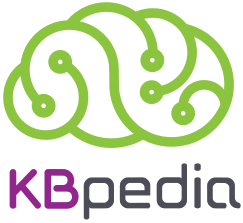 Completing the Schema for the Relations Addition
Completing the Schema for the Relations Addition
In the previous part of this series I discussed the relations model that we are adding to the KBpedia knowledge structure for its upcoming version 1.50. This article continues that discussion by fleshing out the concept hierarchy for this relations addition. These changes are taking place within the upper structure of KBpedia, what we call the KBpedia Knowledge Ontology, or KKO. The addition of this relations model affects both the class hierarchy of KKO and its properties structure. Both aspects are discussed below.
The previous parts of this series introducing the new KBpedia v 150 provide the rationale for adding a relations or predications structure to KBpedia, as well as the rationale for grounding this structure in the universal categories and logic of relations developed by Charles Sanders Peirce. Let me expand on those arguments a bit further here.
Recall from the earlier parts in this discussion that we want to adopt a schema for relations because we are interested in assertions and propositions in our knowledge structures. As Peirce notes [1],”The unity to which the understanding reduces impressions is the unity of a proposition. This unity consists in the connection of the predicate with the subject; and, therefore, that which is implied in the copula, or the conception of being, is that which completes the work of conceptions of reducing the manifold to unity.” (CP 1.548). The previous part discussed the rationale for three main classes of relationship types and how they related to Peirce’s views on logic and the theory of signs (semiosis). It is now time to expand on those distinctions.
The Second Level of the Relations Hierarchy
At the top level, relations are defined in KBpedia as belonging to one of three main types: Attributes, which are how we describe and characterize individual things (using the shorthand of A:A); External Relations, which are how an individual thing may relate, interact or situate with regard to external things (using the shorthand of A:B); or Representations [3], which are how we may name or define, indicate or reference, or provide supporting information about an individual thing (using the shorthand of re:A). These three main categories capture every conceivable form of relation. Note that an individual thing may also include classes or types, as well as individuals. Through this means, we can talk about and refer to categories, concepts, classes or types when we need to consider them as things unto themselves.
These three main categories correspond to Peirce’s universal categories of Firstness, Secondness and Thirdness [2]. (Where appropriate, I also sometimes footnote some Peirce quotes relevant to the category at hand.) Using the same trichotomous approach to categorization [2], we can now expand these three main relational categories into a second level of nine categories:
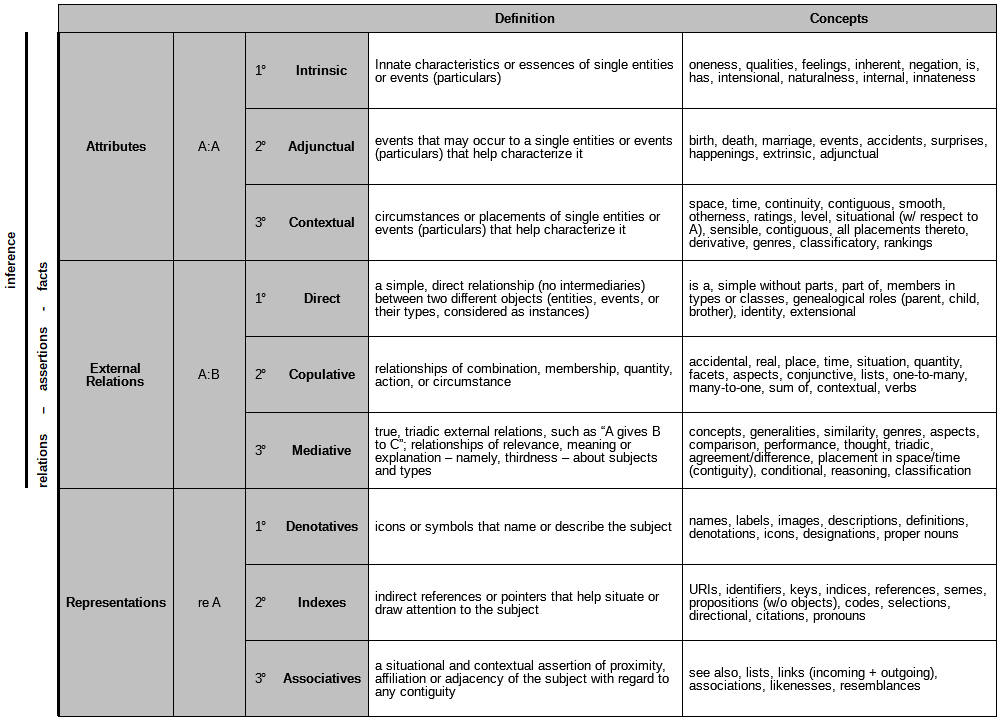
For Attributes (A:A), the split is into these three categories:
- Intrinsic — innate characteristics or essences of single entities or events (particulars). Example concepts include oneness, qualities, feelings, inherent, negation, is, has, intensional, naturalness, internal, innateness
- Adjunctual — events that may occur to a single entities or events (particulars) that help characterize it. Example concepts include birth, death, marriage, events, accidents, surprises, happenings, extrinsic, adjunctual
- Contextual — circumstances or placements of single entities or events (particulars) that help characterize it. Example concepts include space, time, continuity, contiguous, smooth, otherness, ratings, level, situational (w/ respect to A), sensible, contiguous, all placements thereto, derivative, classificatory, rankings.
For External Relations (A:B), the split is into these three categories:
- Direct — a simple, direct relationship (no intermediaries) between two different objects (entities, events, or their types, considered as instances). Example concepts include is a, simple without parts, part of, members in types or classes, genealogical roles (parent, child, brother), identity, extensional
- Copulative — relationships of combination, membership, quantity, action, or circumstance. Example concepts include accidental, real, place, time, situation, quantity, facets, aspects, conjunctive, one-to-many, many-to-one, sum of, contextual, verbs
- Mediative — true, triadic external relations, such as “A gives B to C”; relationships of relevance, meaning or explanation – namely, thirdness – about subjects and types. Example concepts include concepts, generalities, similarity, genres, aspects, comparison, performance, thought, triadic, agreement/difference, placement in space/time (contiguity), conditional, reasoning, classification.
And, for Representations (re:A), the split is into these three categories:
- Denotatives — icons or symbols that name or describe the subject. Example concepts include names, labels, images, descriptions, definitions, denotations, icons, designations, proper nouns
- Indexes — indirect references or pointers that help situate or draw attention to the subject. Example concepts include URIs, identifiers, keys, indices, references, semes, propositions (w/o objects), codes, selections, directional, citations, pronouns [4]
- Associatives — a situational and contextual assertion of proximity, affiliation or adjacency of the subject with regard to any contiguity. Example concepts include see also, lists, links (incoming + outgoing), associations, likenesses, resemblances [5].
The Third Level of the Relations Hierarchy
For the next level, we can continue with our process of categorization based on the universal categories applied to the nine categories listed above. Here is the schema that results from this approach:
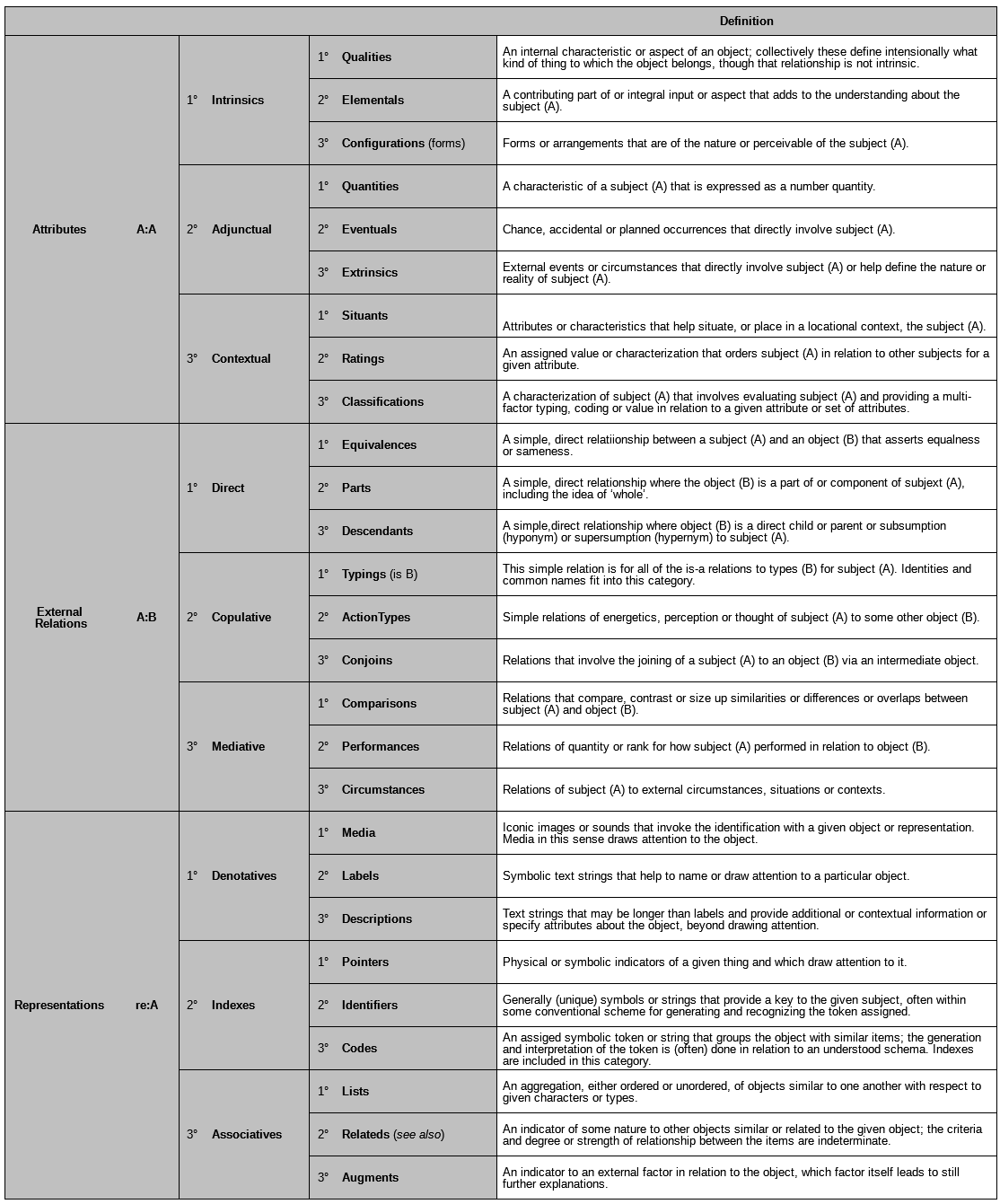
For the mid-level category of Intrinsics, the first of three categories under Attributes, here are the three subsidiary categorizations (representing the Firstness, Secondness and Thirdness, respectively):
- Qualities — an internal characteristic or aspect of an object; collectively these define intensionally what kind of thing to which the object belongs, though that relationship is not intrinsic
- Elementals — a contributing part of or integral input or aspect that adds to the understanding about the subject (A)
- Configurations (forms) — forms or arrangements that are of the nature or perceivable of the subject (A).
For the mid-level category of Adjunctual, here are the three subsidiary categorizations:
- Quantities — a characteristic of a subject (A) that is expressed as a number quantity
- Eventuals — chance, accidental or planned occurrences that directly involve subject (A)
- Extrinsics — external events or circumstances that directly involve subject (A) or help define the nature or reality of subject (A).
For the mid-level category of Contextual, here are the three subsidiary categorizations:
- Situants — attributes or characteristics that help situate, or place in a locational context, the subject (A)
- Ratings — an assigned value or characterization that orders subject (A) in relation to other subjects for a given attribute
- Classifications — a characterization of subject (A) that involves evaluating subject (A) and providing a multi-factor typing, coding or value in relation to a given attribute or set of attributes.
For the mid-level category of Direct, the first of three categories under External Relations, here are the three subsidiary categorizations:
- Equivalences — a simple, direct relatiionship between a subject (A) and an object (B) that asserts equalness or sameness
- Parts — a simple, direct relationship where the object (B) is a part of or component of subject (A), including the idea of ‘whole’
- Descendants — a simple, direct relationship where object (B) is a direct child or parent or subsumption (hyponym) or supersumption (hypernym) to subject (A).
For the mid-level category of Copulative, here are the three subsidiary categorizations:
- Typings (is B) — this simple relation is for all of the is-a relations to types (B) for subject (A). Identities and common names fit into this category
- ActionTypes — simple relations of energetics, perception or thought of subject (A) to some other object (B)
- Conjoins — relations that involve the joining of a subject (A) to an object (B) via an intermediate object.
For the mid-level category of Mediative, here are the three subsidiary categorizations:
- Comparisons — relations that compare, contrast or size up similarities or differences or overlaps between subject (A) and object (B)
- Performances — relations of quantity or rank for how subject (A) performed in relation to object (B)
- Circumstances — relations of subject (A) to external circumstances, situations or contexts.
For the mid-level category of Denotatives, the first of three categories under Representations, here are the three subsidiary categorizations:
- Media — iconic images or sounds that invoke the identification with a given object or representation. Media in this sense draws attention to the object [6]
- Labels — symbolic text strings that help to name or draw attention to a particular object
- Descriptions — text strings that may be longer than labels and provide additional or contextual information or specify attributes about the object, beyond drawing attention.
For the mid-level category of Indexes, here are the three subsidiary categorizations:
- Pointers — physical or symbolic indicators of a given thing and which draw attention to it
- Identifiers — generally (unique) symbols or strings that provide a key to the given subject, often within some conventional scheme for generating and recognizing the token assigned
- Codes — an assigned symbolic token or string that groups the object with similar items; the generation and interpretation of the token is (often) done in relation to an understood schema. Indexes are included in this category.
And, lastly, for the mid-level category of Associatives, here are the three subsidiary categorizations:
- Lists — an aggregation, either ordered or unordered, of objects similar to one another with respect to given characters or types
- Relateds (see also) — an indicator of some nature to other objects similar or related to the given object; the criteria and degree or strength of relationship between the items are indeterminate
- Augments — an indicator to an external factor in relation to the object, which factor itself leads to still further explanations.
These categories, then, complete the three levels underneath the KBpedia Knowledge Ontology’s Predications branch (itself a Secondness under the basic Thirdness of Generals). We have established these as concepts within KKO such that we may reason over the ideas of these categories, and do other conceptual work with them. This conceptualization is helpful in order to consider the ideas of predicates and the relationships between them. However, for mapping properties from external sources, we need a parallel structure in terms of KKO properties.
An Analogous Structure for Properties
We thus created an analogous structure for properties within KBpedia. One useful addition that is forthcoming in the KBpedia v 1.50 release is a mapping of 2500 Wikidata properties to this property schema, which represents more than 95% of all property assignments to the 25 million+ entities within Wikidata. This is one of the first tangible expressions of the benefits of having a fully rational predicate structure within KBpedia.
Attributes, External Relations and Representations comprise OWL properties. In general, Attributes correspond to the OWL datatypes property; External Relations to the OWL object property; and Representations to the OWL annotation properties. These specific OWL terms are not used in our KKO grammar, however, because some attributes may be drawn from controlled vocabularies, such as colors or shapes, that can be represented as one of a list of attribute choices. In these cases, such attributes are defined as object properties. Nonetheless, the mappings of KKO’s grammar to existing OWL properties is quite close. In all cases, our mappings to external sources are done via the subPropertyOf relation in OWL.
Object and Data Properties
Because a given external non-annotation property (that is, all properties except Representations) may either refer to another object (IRI) or to a string or data value, we created parallel listings of object and datatype properties within KKO. Here is the listing for the object properties group as shown by a screen capture from Protégé:
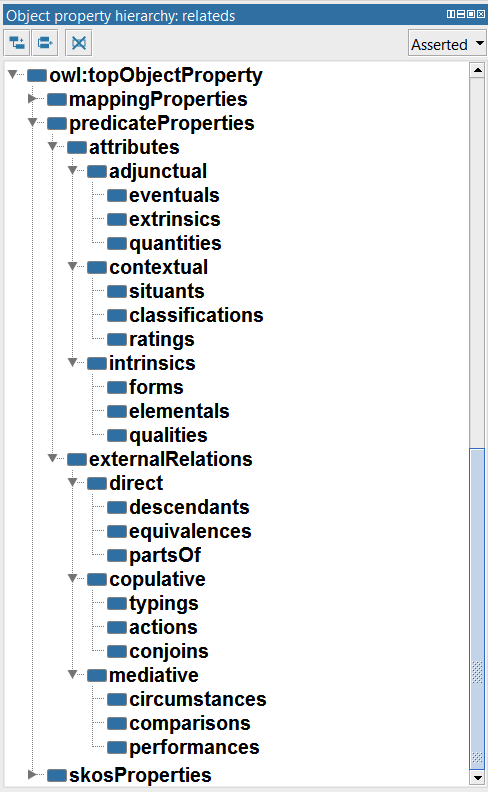
Note that Protégé lists its items alphabetically, rather than our preferred ordering of Firstness, Secondness and Thirdness. You also should note the parallelism to the concept hierarchy discussed above. Not shown is the similar datatype properties structure.
Annotation Properties
As noted, Representations correspond to annotation properties, and that listing is shown in this screen capture:
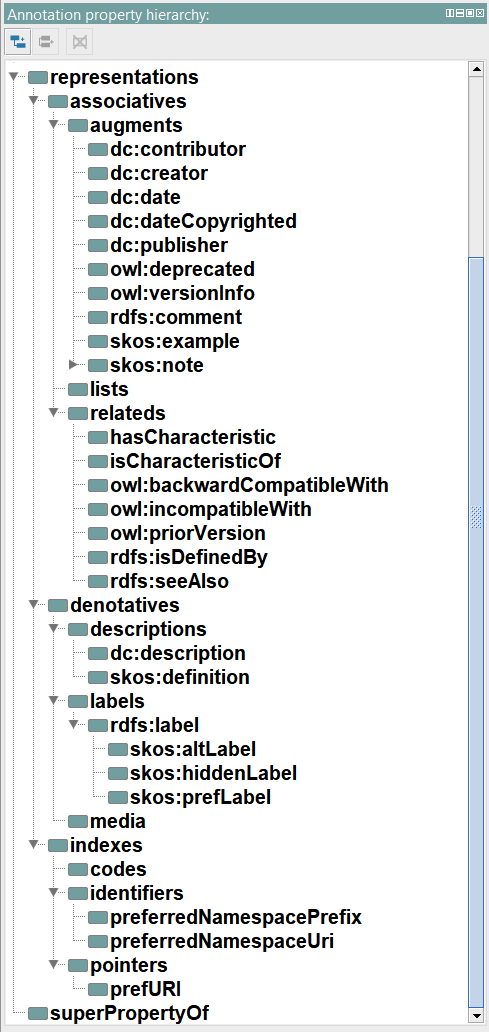
In OWL2, annotations may be organized in a subPropertyOf manner, even though inferencing is not possible over this structure. The organization, though, is helpful to understand relationships (and they can independently be reasoned over with the matching concept structure) and may be used in search, SPARQL or external analytic scripts.
We also organize the SKOS and Dublin Core annotation properties used by KKO into the categorical structure of these Representations, as shown by the screen capture above. This organization helps elucidate the structure under the Representations branch using these commonly applied properties.
Some Caveats and Next Part
This completes the hierarchical specification of the Predications branch within KKO. These 39 categories (3 + 9 + 27), following the categorization approach suggested by Peirce’s universal categories, now complete our additions to this next version of KBpedia.
This addition has been under intense and active development for the past year, though it has been in the works for much longer than that. Over that time, the names of categories and, indeed, even the splits themselves, have changed frequently and evolved. Peirce’s Logic of Relatives [7], as one of the two main sources, is itself laid out in a dichotomous structure, though elsewhere in Peirce’s writings — as we showed in the previous parts — these are often expressed in Peirce’s more standard trichotomous structure. I am sure with use and more experience that we will see further refinements to the KBpedia relations schema as time goes on. Please do not be surprised if you see further changes.
We are now nearly complete with the advance material leading up the KBpedia v 1.50 release. We will have one next part in our series recapitulating the terminology and grammar for this new version. The announcement following that will finally release version 1.50.





